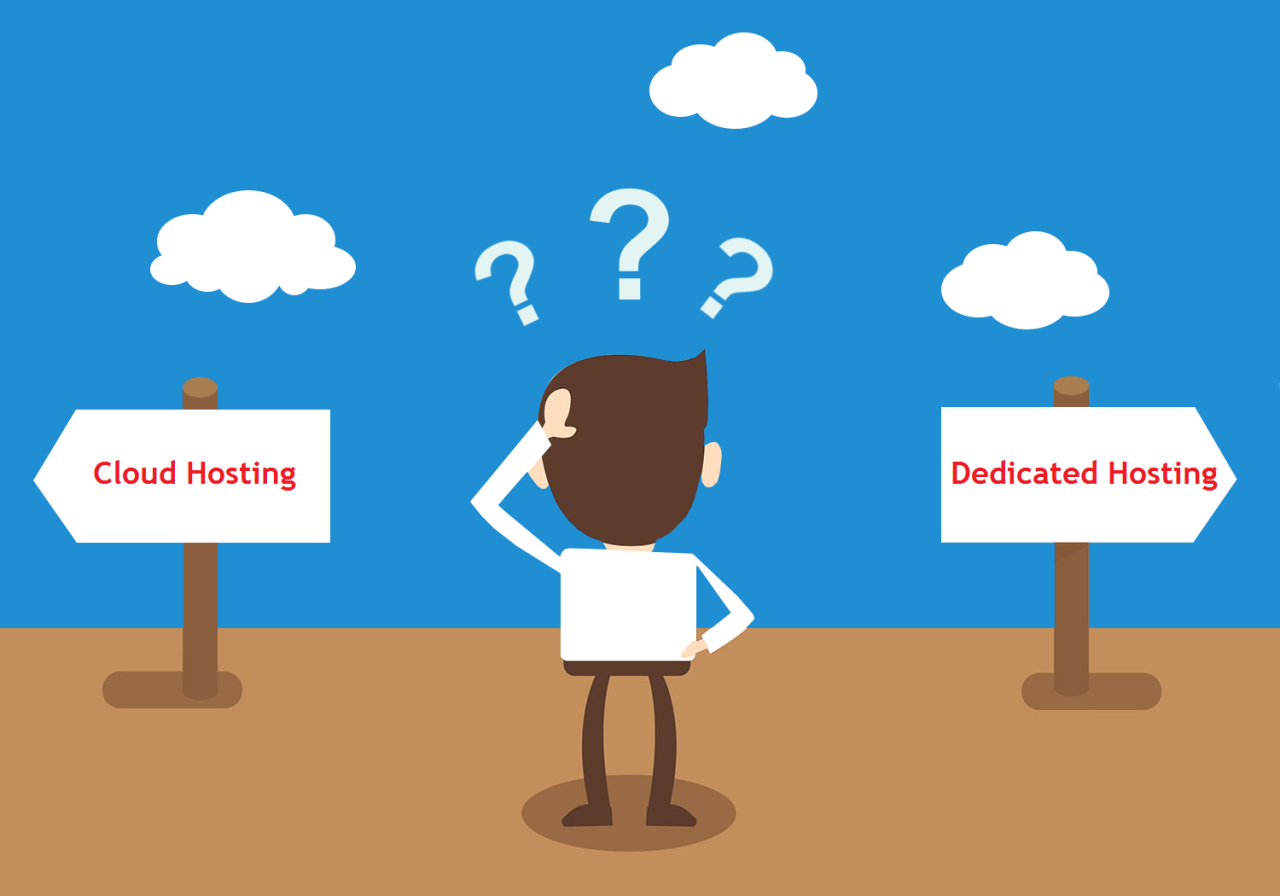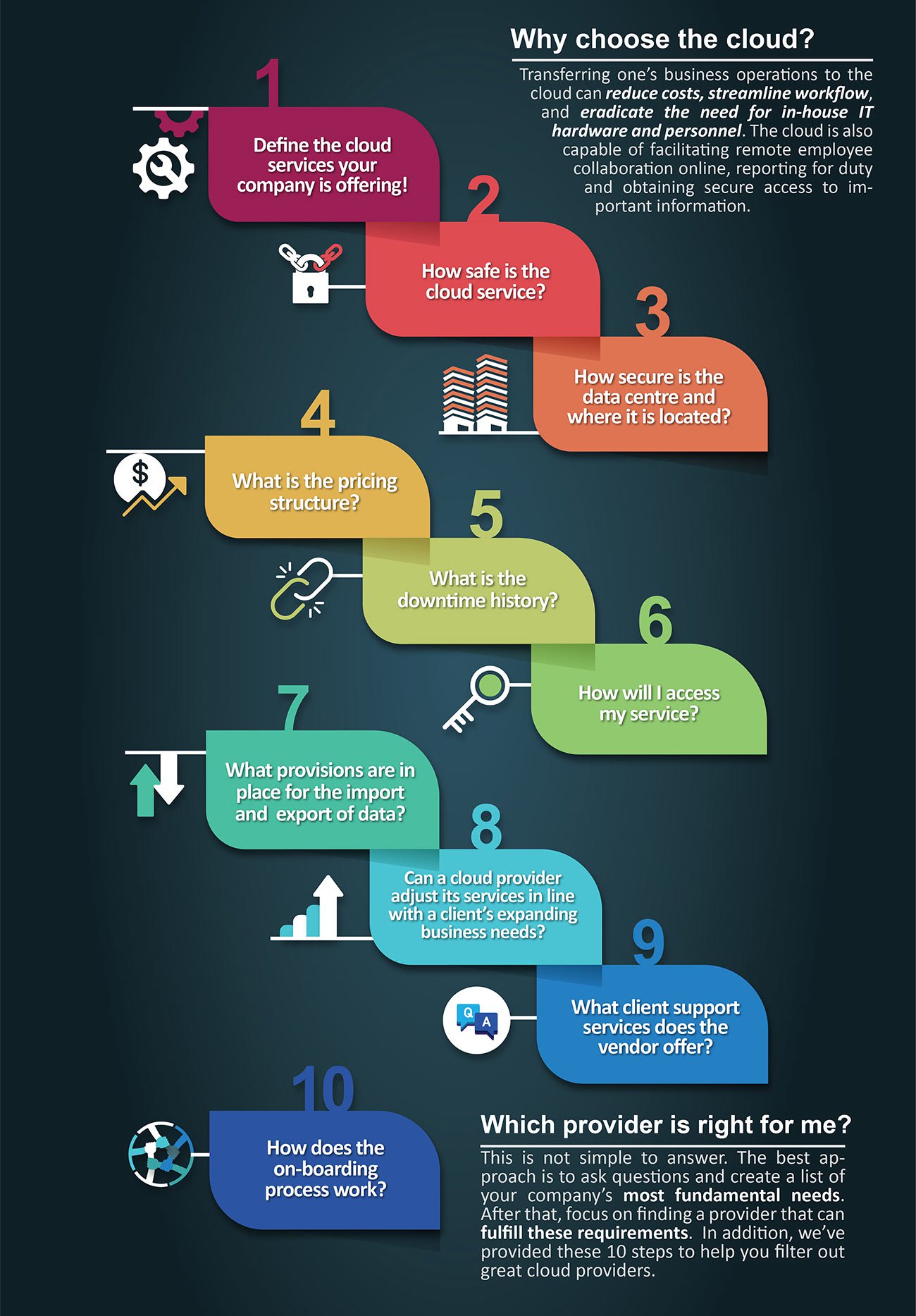Guide 10 Steps to Choose the Best Cloud Provider
Transferring one’s business operations – document storage and e-mails – to a cloud can reduce costs, streamline his/her workflow, and eradicate the need for in-house IT hardware and personnel. A good cloud provider is also capable of facilitating remote employee collaboration online, reporting for duty and obtaining secure access to important information.
Probably the largest perk for small-sized enterprises is the ability to focus on core business activities and let the cloud-based service tackle troublesome IT concerns, such as support, maintenance, backup, and security.
Among a plethora of companies providing an ever-growing assortment of great cloud solutions, selecting the most suitable one has become quite daunting a task. For this reason, today, we are presenting you 10 steps to choose the best cloud provider. While you are screening the potential cloud service providers, you will be able to choose the best one tailored to your specific needs.

1. Define the cloud services your company is offering?
Being cognizant of your cloud computing needs will give you an idea of the type of service you are seeking.
There are various cloud solutions that are software-based. For instance, Dropbox is for photo, video, and document storage. Salesforce provides online customer relationship management (CRM) services. Online accounting is Intuit’s speciality.
Should you necessitate something more than just basic storing of data? There are enterprises that provide an array of cloud computing solutions for general purposes, such as infrastructure for IT networking combined with on-demand access to software, applications, and virtual servers. Amazon Web Services, CloudSigma, IBM SmartCloud Enterprise, and GoGrid are such vendors.
2. How safe is the cloud service?
Online safety and security are of paramount importance when it comes to storing an enterprise’s fundamental data in a cloud.
Providers of cloud computing solutions should possess at least several standard security measures set in place. In addition, they need to be updated constantly to thwart the heaps of malicious attacks that occur every day. For your good night sleep, you must ensure a cloud provider’s security is immaculate.
Seek security measures, such as anti-virus detection, firewalls, routine security audits, as well as data encryption and multiple user verification. Certifications such as ISO27001 can validate that those measures are in place (they usually require regular auditing of the company). Additionally you can ask for details of the company’s track record on security, any known security incidents and breaches etc. Another good idea is to inquire about who is going to have an access to your cloud data and whether the cloud solutions provider performs background checks of its employees to set aside identity thieves or potential cybercriminals.
Other questions cloud providers should be able to answer are in regard to compliance with industry-specific government legislation. For instance, if your business is in the betting industry, you’ll want to ensure your cloud provider complies with the stipulations of the Gambling Commission, which is charged with carrying out reviews and visits, giving guidance or specific advice to licence holders, and reviewing financial information.
3. How secure is the data centre and where it is located?
The security and location of the servers and data centres where your company’s data will be kept are of the same importance as online safety. You will want to safeguard that you are not dealing with a cloud provider whose servers are kept in a basement where anyone can break in and get his hands on sensitive data.
To ensure that’s not the case, it’s essential to ask your potential cloud solutions retailer how it protects its servers from natural disasters, such as storms, floods, fires, and earthquakes. Also, don’t forget to inquire about the different types of physical breach protection provided. For example, how the facilities are protected against thieves that would go after your private information, both physically and virtually.
The ISO27001 standard, is probably the best indicator that the data centres of a cloud merchant can bear up to legions of security attacks. The ISO27001 certification showcases that an enterprise’s data, systems, and products comply with the industry security standards for data redundancy, physical security of the data servers, privacy and customer access.
4. What is the pricing structure?
When aiming to choose the best cloud provider, pricing can definitely be the deciding factor. It boils down to the fact that you should only be paying for what you are using. Beware of gigantic upfront charges, which are not typical of trustworthy cloud providers or lock-in clauses.
From the beginning, the pricing structure should be pay-as-you-go, with the ability to include extra services if required. Contingent upon the provider, the costs are typically charged on an hourly, monthly, quarterly, semi-annual, and annual basis. Prices can differ substantially, from as low as $1 monthly per user to over $100 a month.
5. What is the downtime history?
Downtime is a period of time when a service is effectively not accessible to users. The best answer to this critical question is NEVER however that isn’t realistic. Nonetheless, even the largest and most respected cloud vendors experience downtime from time to time.
Since cloud outages can be costly and quite disruptive for one’s business, it’s best to opt out for a vendor that has as few as possible. It’s also vital that the company takes an open and transparent approach to incidents when they do happen. The same principle applies to solutions and improvements suggested by the provider as a result. As such, look for those providers that publish their downtime history logs on their websites for example http://status.cloudsigma.com. If they lack these reports, make sure to inquire about the track record, generally online reporting should be preferred.

6. How will I access my service?
An individual should be able to access his/her business data in the cloud from any exotic location at any point in time just by logging into his/her vendor’s customer login page. He/she should also be able to sign in using any device, including one’s laptop, tablet, or smartphone.
7. What provisions are in place for the import and export of data?
One of the most effective vendor lock-ins is lack of data portability. Forget about open standards, APIs and others, if you can’t move your data from one provider to another you are locked in. Look for banked in data export (and import) functionality to the service which is free (or cheap), easy to use and readily available. As service that lacks this may be very expensive to leave if you change your mind at some point in the future. Even if you are only on a monthly rolling contract, if transferring to another service is very cumbersome, time consuming and risky, how cheap really is that service in reality? Data portability is probably the single most overlooked issue customers of cloud services fail to adequately check.
8. Can a cloud provider adjust its services in line with a client’s expanding business needs?
While your business activities are growing, your cloud service needs are likely to expand, too. To safeguard that you are selecting a good and flexible cloud vendor, learn what extra capacity it provides and the cost. Ideally a service which gets cheaper on a per unit basis as you expand is ideal.
If your prospects include staff expansion, you will have to ensure that adding new users to your account is effortless.
9. What client support services does the vendor offer?
To choose the best cloud provider, always be on the look out for a highly available and efficient support system. You should have online access to customer support 24/7/365, without any exceptions, including holidays. Some vendors include this for free, others charge varying amounts for it and it’s quite critical to have if you are putting any important business services in the cloud. Check this before buying any service.
Quality varies also, make sure you are aware of the average time for response and resolution. In addition, look into whether the technical support is provided by seasoned engineers or support service representatives that read or copy scripts instead of addressing your issue individually. The former is obviously better and will save you a lot of time when engaging support services in resolving issues.
10. How does the on-boarding process work?
After selecting and signing with a cloud vendor, the next step is usually to sign in and configure the account. This also entails adding employees as users.
There are cloud providers that walk users through the installation process. However, there are others – Amazon and Google, for instance – that just offer online introductory guides.
Those are our tips on how to choose the best cloud provider, we hope you find them useful!
Guest Blog Post by: Svetoslav Dimitrov
Operate and exploit advertising by iCOMM Vietnam Media and Technology Joint Stock Company.
Adress: 99 Nguyen Tat Thanh, To 2, Khu 6, Thi tran Tan Phu, Tan Phu, Dong Nai.
Email: [email protected] | Tel: (+84) 984654960
Editor in chief: Tran Nha Phuong
Company: Lucie Guillot (Nha Phuong Tran)




